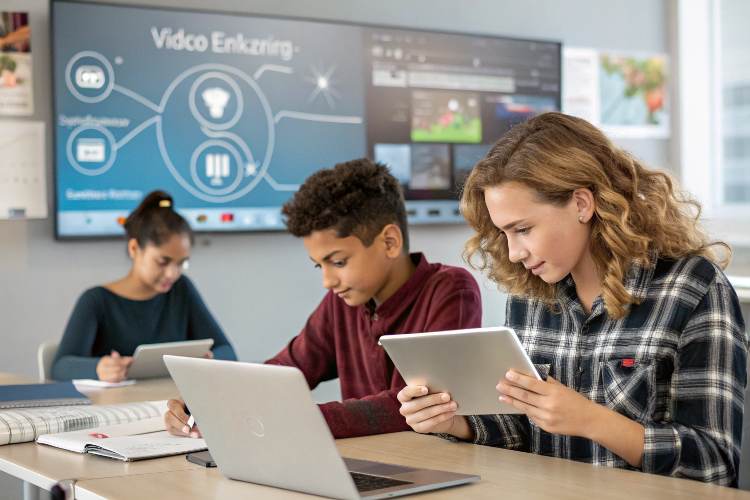Blog
How Microlearning is Making Online Education More Effective ?
EdTech & Online Learning ▪ 2025-03-13

The world of online education is evolving rapidly, and one of the most powerful trends shaping the future of learning is microlearning. As attention spans shrink and digital distractions increase, traditional long-form learning models are becoming less effective. Microlearning offers a more engaging, flexible, and efficient way to absorb knowledge, making it a game-changer for students, professionals, and organizations.
Microlearning breaks down complex subjects into bite-sized, easily digestible lessons that focus on specific learning objectives. Whether through short videos, infographics, interactive quizzes, or mobile apps, microlearning enables learners to retain information better, stay engaged, and apply knowledge faster.
In this blog, we’ll explore how microlearning is transforming online education, its key benefits, best practices, and the future of bite-sized learning experiences.
1️⃣ What is Microlearning? Understanding the Basics
🚀 Microlearning is a modern educational approach that delivers short, focused learning modules designed for quick understanding and retention.
✔ Instead of spending hours on long lectures or reading extensive textbooks, learners can grasp key concepts in minutes.
✅ Core Characteristics of Microlearning:
✔ Bite-Sized Content – Lessons are typically 2 to 10 minutes long.
✔ Single Learning Objective – Each module focuses on one key concept or skill.
✔ Interactive & Engaging – Uses videos, quizzes, infographics, and gamification.
✔ On-Demand & Mobile-Friendly – Allows learners to access content anytime, anywhere.
✔ Retention-Focused – Uses spaced repetition and reinforcement to improve memory recall.
💡 Example: A Duolingo lesson teaches a single language concept in just 5 minutes, reinforcing learning through repetition.
🔗 Pro Tip: Microlearning aligns with modern learners' needs by providing quick, focused, and accessible education.
2️⃣ The Science Behind Microlearning: Why It Works
✔ Cognitive science and learning psychology support the effectiveness of microlearning.
✔ Short, focused lessons prevent cognitive overload, making learning more effective.
✅ Scientific Reasons Why Microlearning Works:
✔ The Forgetting Curve (Ebbinghaus Theory) – Learners forget 80% of new information within a few days without reinforcement. Microlearning combats this through spaced repetition.
✔ Active Recall & Reinforcement – Interactive quizzes and practice exercises boost retention.
✔ Cognitive Load Theory – Smaller chunks of information are easier to process and remember.
✔ Dopamine & Engagement – Gamified elements trigger dopamine release, keeping learners motivated.
💡 Example: An employee training platform uses microlearning to deliver 3-minute compliance videos, followed by a quick quiz to reinforce learning.
🔗 Pro Tip: Microlearning keeps learners engaged by leveraging memory science and interactive experiences.
3️⃣ The Benefits of Microlearning in Online Education
✔ Microlearning is revolutionizing e-learning platforms, corporate training, and skill development programs.
✔ It provides a flexible, personalized, and effective learning experience.
✅ Key Benefits of Microlearning:
✔ Higher Engagement Rates – Shorter lessons keep learners focused and motivated.
✔ Faster Knowledge Retention – Small information chunks improve long-term memory recall.
✔ Time-Efficient & Flexible – Ideal for busy professionals and students with limited time.
✔ Cost-Effective for Businesses – Reduces training costs while improving employee performance.
✔ Mobile-Optimized Learning – Supports on-the-go education through mobile apps.
💡 Example: Companies like Google and IBM use microlearning for employee upskilling, reducing training time while increasing productivity.
🔗 Pro Tip: For maximum impact, microlearning should be combined with interactive elements like quizzes and real-world application scenarios.
4️⃣ How Microlearning is Transforming Different Industries
✔ Microlearning isn’t just for students—it’s reshaping corporate training, healthcare education, and professional skill development.
✔ It enables learners in various industries to quickly acquire and apply knowledge.
✅ Microlearning in Different Sectors:
✔ 🎓 Education & E-Learning Platforms – Used in online courses for faster skill-building (e.g., Udemy, Coursera).
✔ 🏢 Corporate Training & Employee Development – Helps companies train employees in soft skills, compliance, and leadership.
✔ 🏥 Healthcare & Medical Training – Doctors and nurses use short modules to stay updated on new medical procedures.
✔ 🛠 Technical & IT Skills – Developers and engineers learn coding concepts through micro-courses on platforms like Codecademy.
✔ 🎯 Marketing & Sales Training – Sales teams improve their pitches with bite-sized learning materials.
💡 Example: A digital marketing agency trains employees with daily 5-minute lessons on SEO, PPC, and content marketing strategies.
🔗 Pro Tip: Businesses and educators should integrate microlearning into training programs to improve knowledge retention and engagement.
5️⃣ Best Practices for Creating Effective Microlearning Content
✔ To maximize the impact of microlearning, content should be well-structured, engaging, and optimized for retention.
✅ How to Create Effective Microlearning Modules:
✔ Focus on One Concept per Lesson – Keep it simple and clear.
✔ Use Multimedia (Videos, Infographics, Audio) – Visuals improve engagement.
✔ Incorporate Interactive Elements – Add quizzes, challenges, and simulations.
✔ Make it Mobile-Friendly – Optimize content for smartphones and tablets.
✔ Apply Spaced Learning & Reinforcement – Repeat key lessons for better retention.
💡 Example: A cybersecurity training course delivers 2-minute lessons on phishing scams, followed by a short quiz for practice.
🔗 Pro Tip: Microlearning should be personalized, engaging, and tailored to the learner's needs.
6️⃣ The Future of Microlearning: AI, Gamification, and Beyond
✔ The future of online education is being shaped by AI, gamification, and adaptive learning technologies.
✔ Microlearning will continue to evolve, integrating smart AI-powered assistants, virtual reality (VR), and interactive simulations.
✅ Upcoming Trends in Microlearning:
✔ AI-Powered Personalized Learning – AI will analyze learner behavior and recommend tailored lessons.
✔ Gamification & Rewards – Leaderboards, badges, and challenges will enhance engagement.
✔ Voice & Chatbot-Based Microlearning – Learning through AI-driven virtual assistants.
✔ AR/VR-Based Microlearning – Immersive, hands-on training experiences.
✔ Blockchain for Credentialing – Secure digital certificates for completed micro-courses.
💡 Example: AI-powered chatbots could deliver microlearning lessons through platforms like WhatsApp and Slack.
🔗 Pro Tip: The integration of AI and gamification will make microlearning more engaging and adaptive.

